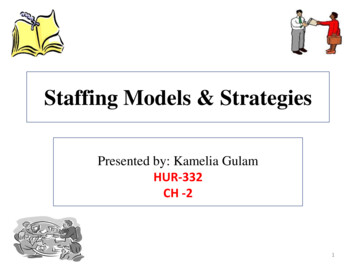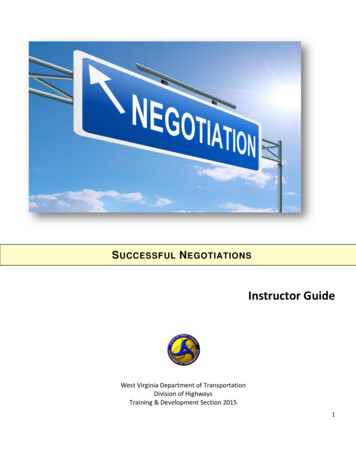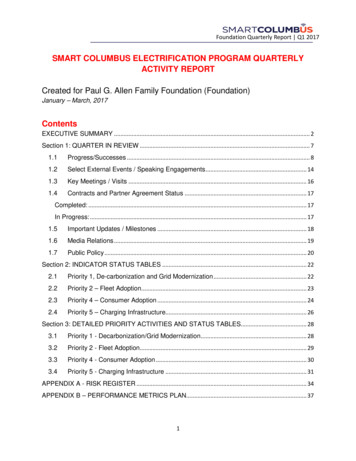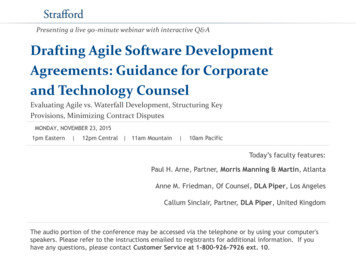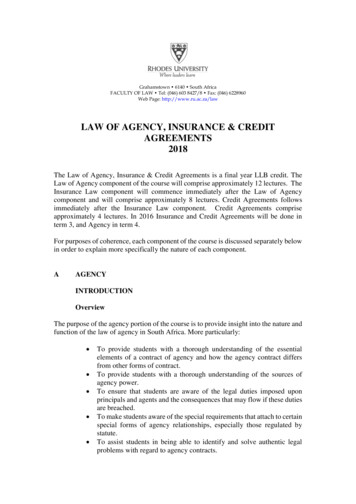
Transcription
Presenting a live 90-minute webinar with interactive Q&ANegotiating Staffing Agency Agreements:Drafting Key Provisions, MinimizingIndividual and Joint-Employer LiabilityWEDNESDAY, JANUARY 11, 20171pm Eastern 12pm Central 11am Mountain 10am PacificToday’s faculty features:Janette Levey Frisch, Founder, The EmpLAWyerologist Firm, East Brunswick, N.J.Jacob M. Sitman, Shareholder, Chair of Employment Law and Labor Relations,Fitzpatrick Lentz & Bubba, Center Valley, Pa.The audio portion of the conference may be accessed via the telephone or by using your computer'sspeakers. Please refer to the instructions emailed to registrants for additional information. If youhave any questions, please contact Customer Service at 1-800-926-7926 ext. 10.
Tips for Optimal QualityFOR LIVE EVENT ONLYSound QualityIf you are listening via your computer speakers, please note that the qualityof your sound will vary depending on the speed and quality of your internetconnection.If the sound quality is not satisfactory, you may listen via the phone: dial1-866-370-2805 and enter your PIN when prompted. Otherwise, pleasesend us a chat or e-mail sound@straffordpub.com immediately so we can addressthe problem.If you dialed in and have any difficulties during the call, press *0 for assistance.Viewing QualityTo maximize your screen, press the F11 key on your keyboard. To exit full screen,press the F11 key again.
Continuing Education CreditsFOR LIVE EVENT ONLYIn order for us to process your continuing education credit, you must confirm yourparticipation in this webinar by completing and submitting the AttendanceAffirmation/Evaluation after the webinar.A link to the Attendance Affirmation/Evaluation will be in the thank you emailthat you will receive immediately following the program.For additional information about continuing education, call us at 1-800-926-7926ext. 35.
ResponsibilitiesStaffing Firm:Client: Pre-employment screening and hiring; Determine start date and length ofassignments; Determine pay rates and benefits, if any; Direct employees’ daily work activities;Pay wages and employment taxes; Control employees’ work environment;Provide Workers’ CompensationCoverage; Conduct workplace safety and training. Handle employees’ complaints andquestions; Discipline, terminate, re-assign.4
In Contracts With StaffingFirm/Contractor Compliance:a) Staffing firm must comply with all laws,including all employment laws and have all required licensesand registrations; b) Specifically require compliance with lawsthat apply to your company and might not otherwise apply tothe staffing firm (e.g. federal contractor rules, E-Verify, exportcontrol rules, HIPAA); Any special rules for recruiting, screening, and/or backgroundchecks. Employer-of-Record: All staffing firm workers assigned toyour company are staffing firm’s W-2 employees, unless youspecifically agree otherwise in writing.5
In Contracts With StaffingFirm/Contractor Monitoring Compliance with Agreement and Laws: Client shouldreserve the right to audit staffing firm documents for compliance withany legal and/or contractual requirements (e.g. payroll records, I-9s,documents required to be signed by the workers, etc). Client shouldrequire that staffing firm have all assigned workers sign documentsclient wants them to sign. Client and staffing agency should each have a contact person whomonitors compliance, and who deals with any issues that arise. Staffingfirm should have a contact person that deals with scheduling, employeerelations and other administrative issues. Workers should not be goingdirectly to client on those issues, client should not deal directly withcontingent worker. One or more indemnities, applicable if staffing firm violates legal orcontractual requirements.6
Indemnity/Limitation of LiabilityProvisionsDefend, indemnify and hold harmlessClaims or losses incurred and proximate causationFault, negligence, gross negligence, willfulmisconduct or recklessnessIndemnification precondition: written notice to theother party within a timeframe of receipt of anyclaim, demand or notice for which indemnificationmay be soughtLimits/exclusion regarding liability for incidental,consequential, punitive, indirect or special damages(interruption of or loss of business, profit orgoodwill)7
Confidentiality/NonsolicitationProvisionsWill assigned employee’s knowledge, possession oruse of staffing firm’s client’s confidential informationbe imputed to the staffing company?Require assigned employees to sign g firm customer solicitation of staffing firmemployee on assignment (or during specific timeperiod without prior written consentConsider liquidated damages and attorneys’ feesprovisions (in lieu of injunctive relief)8
Scope/Term/Termination ProvisionsSurvival of restrictive covenants despite terminationInitial period, automatic extension for successiveperiod of specified length, election to terminatewithin specified timeframe and prior written noticeImmediate termination for nonpayment orbankruptcy9
In Contracts With StaffingFirm/Contractor, cont’d Insurance: Require staffing firm to have CGL, Professional Liability/E&O,Workers’ Compensation, all other applicable coverage, and name clientcompany as additional insured, on primary basis; and as alternate employer onthe Workers’ Compensation coverage.Payment: Include all payment terms. What is due when, what happens whenpayment is late.Guarantee period: Number of hours or weeks in which client can determine ifsatisfied with employee. If not, client is refunded all or part of monies paid forthat/those workers. Staffing firm will not want that time period to be too long orthey are vulnerable to providing free services. Client needs sufficient time todetermine if employee is working satisfactorily.Conversion Fees: Charged when client wants to hire any workers directly.Usually a sliding fee. The sooner the hire date the higher the fee. Usuallyphased out after worker has worked a certain number of hours or weeks.Assignment limits: if desired – and appropriate.10
Joint Employment MythsMyth #1: Joint Employment Increases the Risk of LitigationReality: Hiring temporary employees is no more risky than hiringadditional direct employees. Access to courts is a reality, andcorporations will not avoid lawsuits entirely. Companies do not loselawsuits solely because they are co-employers. Companies loseemployment cases when they base their decisions on illegal criteria.Ensuring proper decision-making is key.Myth #2: Using temporary workers or a variant, automatically creates ajoint employment arrangement.Reality: The use of temporary workers by itself does not create coemployment. Exercising sufficient control over the workers triggers coemployment.11
Joint Employment Myths #3 -5Myth #3 : Being declared a joint employer automatically means damages.Reality: Damages are triggered by decisions based on illegal criteria or bynegligent or willful misconduct. When joint employers work together to ensureappropriate decision-making and conduct, damages are much less likely.Myth #4: : Imposing assignment term limits will prevent a finding of coemployment.Reality: Length of assignments is only one of several factors in determiningwhether there is a co-employment arrangement.Myth #5: : All companies using contingent (temporary) work staff are at risk of aMicrosoft –type situation.Reality: Microsoft failed to think about exactly how it was using its contingentworkers and failed to review its benefits plan. Had it done so the case verylikely would have ended much differently.12
What is a Joint Employer– DOLdefinition “[w]here the employee performs work which simultaneouslybenefits two or more employers, or works for two or moreemployers at different times during the workweek.” A jointemployment relationship generally will be considered toexist in situations such as: Where two employers agree to share the employee'sservices; Where one employer is acting directly or indirectly in theinterest of the other employer (or employers) in relationto the employee; Where the employers are not completely disassociatedwith respect to the employment of a particular employeeand may be deemed to share control of the employee.29 CFR 791.2.13
What Is Joint Employment Liability? Liability of one co-employer for the actions/inactions of another. Occurs most often in the area of anti-discrimination laws,workers’ compensation, OSHA, FMLA, ADA, FLSA, I-9 issues,benefits, and other similar labor and employment laws. Or, claims by employees of one co-employer that they areactually employed by the other co-employer, e.g. entitled to itsemployee benefits.NOTE: Some states also have joint employment laws. Example:California passed a law, effective January 1, 2015, making clientsjointly liable for allegations wage and hour and workers’compensation violations by labor contractors14
Common Joint Employment Issues Discrimination (race, gender, religion, disability, sexualorientation, harassment); Wage and hour; Workers’ Compensation; Workplace Safety; HIPAA. Property damage alleged by temps; Employee benefits; FMLA; I-9 ; Background Checks; Collective Bargaining.15
DiscriminationTitle VII Title VII of the Civil Rights Act of 1964 prohibits discrimination based on race, color, religion,gender, pregnancy, national origin, disability. Applies when there are 15 or more employees.Staffing firms and clients must count direct employees and contingent workers. Harassment based on being a member of these protected classes is a form of discrimination. The Age Discrimination in Employment Act (ADEA) prohibits discrimination based on age. Anyone who exercises a right of control over the worker is an employer under Title VII. Sincemost clients of staffing firms do retain a right of control, they are employers under Title VII. Any firm that can affect a workers’ job can be liable even if it is not an employer under Title VII.Staffing firms and their clients have a joint duty to refrain from discrimination. Staffing firmscannot knowingly assign “temps” to clients that discriminate or comply with a client’sdiscriminatory requests. Note: Most states also have anti-discrimination laws, which impose additional obligations on theemployer. 16
Harassment To minimize harassment liability, staffing firms andclients should: -Have anti-harassment policies and procedures; -Notify employees of those procedures; -Take prompt remedial action.Staffing firms should: - Conduct investigations (with client, if appropriate)- Assure confidentiality whenever possible;- Not retaliate;- Give employee(s) the option of re-assignment;- Not send replacements until the problem is resolved.17
Americans With DisabilitiesAct (ADA) Staffing firms and clients may not ask medical questionsprior to a job offer; Staffing firms can assign another employee if they can’tmake a timely accommodation; Can ask about accommodation if disability is obvious orapplicant voluntarily discloses; Staffing firms and clients should share accommodationcosts. Failure by one to contribute can cause “undue hardship” tothe other.18
EEOC Guidelines Enforcement Guidance: Application of EEO Laws ofContingent Workers Placed By Temporary EmploymentAgencies and Other Staffing Firms Both staffing agency and client generally responsiblefor compliance with law.http://www.eeoc.gov/policy/docs/conting.html Enforcement Guidance on the Application of ADA toContingent Workers Placed By Temporary Agencies andOther Staffing Firms Both staffing agency and client have accommodationand other compliance dacontingent.html19
The EEOC and JointEmployment What Happens in Joint Employer Situations Charge filed by joint employee is filed against bothentitiesJoint employer may not be told about claim filedagainst the otherCharges are mediated, investigated, conciliatedseparatelyInformation from one entity can be used againstthe other entityIf a right to sue letter is issued, it will be up to theCharging Party to decide whether to file onelawsuit against both entities, or file separately.20
Wage and Hour Staffing firms and franchisee-employers generallyhave primary responsibility for record keeping; According to the US Department of Labor, clientsare “joint employers” for overtime pay purposes.21
FMLA See 29 CFR § 825.106 Joint employee must be counted by both employers todetermine employer coverage and employee eligibilityunder the statute. Staffing firm is “primary” employer, responsible for moststatutory compliance including notices. Client company, as “secondary” employer, is responsible foraccepting back the temporary worker returning from leave inplace of any replacement worker (if the client continues touse a temporary worker).22
Workplace Safety Client is primarily responsible for workplacesafety and training. Client must keep records of all illnesses andinjuries of all temporary employees itsupervises. Staffing firms may keep records but must doso in client’s name.23
Workers’ CompensationStaffing firms are the “general employers”Clients are “special employers” if: they supervise the work; the employee consents to the relationship; the employee is doing the work of the client. Both the general and special employer are immune fromliability for injuries if a temporary employee sues and allegesnegligence. Clients are not immune if they: intentionally injure the employee; disclaim employer status.Alternate employer endorsement on temporary staffing firm’s WCcoverage allows the client to put the WC defense on that firm’sinsurance.24
I-9 Compliance According to the USCIS, all co-employers are responsible forI-9 compliance. Department of Homeland Security may impose penalties onboth the staffing firm and the client for non-compliance. Staffing firms can minimize client liability by properlycompleting I-9 forms for its employees and keeping records onits premises. Clients risk liability when they retain I-9’s and relateddocuments for staffing firm employees or become involved inhiring decisions relating to I-9’s and documentation.25
HIPAA If you are a covered entity under HIPAA privacy rules, andtemporary/ contract workers have access to protectedinformation the co-employment issues will arise here too. Clients should include a Business Partner agreement withthe temporary staffing/contractor firm. Clients should require individual agreements signed bythe temporary/contract workers.26
Background Checks Federal and State Fair Credit Reporting Acts; If you use staffing firms and you require temporary workersto be checked, you and the staffing firm must comply withthe applicable federal and state laws; If you impose criteria for the checks, make sure they arelegal; Avoid per se rules; Clients should consider whether27 they want to be involvedin discretionary decisions.27
Employee Benefits Clients must count “leased employees” when applying coverage tests to theirbenefit plans (to determine if they qualify for tax benefits) except group healthplans. Clients only have to count leased employees, not necessarily provide thembenefits.A “leased employee” is one who: works under the primary control of the client; and works “substantially full-time” (i.e. 1500 hours in a year.)Note: If the staffing firm provides benefits, the client still has to count leasedemployees, but client can take “credit” for staffing firm benefits when testing itsown plans.Another Note: : Assignment limits do not necessarily reduce benefits liability andwill not reduce co-employment liability in the other areas discussed in thistraining.28
The Microsoft Case10,000 “independent contractors” and staffing firm employeesassigned to Microsoft since 1987.Two issues: 1) Were they independent contractors or employees?2) If employees, whose were they?Held: “Temps” were common law employees to whom Microsoft hadto provide benefits unless excluded from Microsoft’s 401k plan.(Microsoft settled in 2000 for 97 million).THEREFORE clients should: a) exclude temporary “leased” orcontract employees from their benefits plans; b) consider requiring“leased” employees to sign waivers, preferably tailored to theclient’s specific plans; c) have staffing firm control all preemployment screening, (except specific safety training andorientation), pay rates, benefits, expense reimbursement,assignment, re-assignment, workplace complaints and discipline.29
NLRB and Joint EmploymentHow the NLRB’s Position on Joint Employment Evolved Pre-1982, NLRB’s focus was on the “right to control” work of employees Putative employer had the right to hire, set wages, set working hours,approve overtime, determine manner and method of work, inspect andapprove work, discipline and terminate. Control may be direct or indirectJoint employer status found when entities “share or codetermine thosematters governing the essential terms and conditions of employment.1982 -2015, NLRB narrowed the standards for joint employer Right to control not enough; joint employer status turned exclusively onactual exercise of control. Control must be direct, immediate and not“limited and routine”See Browning-Ferris Industries Decision, 362 NLRB No. 186 (2015), whicharticulates this new-old standard. Cases now before the National Labor Relations Board as to whether employees supplied bystaffing companies must be included in collective bargaining agreements. If yes, then both theclient and the staffing company may be required to bargain with the employees’ collectivebargaining representative. The NLRB will look primarily to whether a client exercises sufficient control or has a right toexercise control in determining a joint employer arrangement.30
Managing Joint Employment Risks Client’s supervisors must not act like employers, e.g. DON’T:hire temporary workers, fire, set compensation or benefits,offer bonuses, grant leaves, deliver performance reviews,make promises, discuss transfers or advancements, etc.Staffing firm/contractor should take all these actions;Clients direct the work, train as needed (when staffing firmdoesn’t), provide safe workplaceClient should have a direct contact at staffing firm/contractorand discuss all changes (removing/adding workers,disciplines, pay issues, etc.) with the contact and havestaffing firm implement, especially those that could havelegal consequences, reaching agreement BEFORE makingfinal decision.Make sure “temps” sign agreements regarding:confidentiality, IP ownership, staffing company is directemployer, non-entitlement to client’s benefits, antiharassment policies and other rules of conduct.31
DOJ v. 1st Class Staffing(December 2016)Enforcement action by DOJ’s Office of SpecialCounsel of Immigration-Related Unfair EmploymentPractices against Utah-based staffing companydiscriminated against employees during onboardingprocess on basis of citizenship and immigration statusby requiring non-U.S. citizens to provide specificdocuments for employment eligibility verificationImmigration and Nationality Act’s anti-discriminationprovision (8 U.S.C. § 1324b)Staffing company agreed to pay 17,600 to settleclaims, pay back wages to the complaining employee,and undergo training on anti-discrimination law, andbe subject to government monitoring for 1 year32
Garcia-Celestino v. Ruiz Harvesting, Inc.,(11th Cir. December 2016)Affirmed finding that citrus grower was joint employerof temporary foreign/H-2A workers recruited fromMexico who were denied minimum wage (the adverseeffect wage rate) and contractual pay by a laborcontractor/staffing firmFLSA broad definition of “employer”/narrow commonlaw definition based on breach of contract claimStaffing form was listed as employer on DOL forms toget visas approved and was responsible for workers’pay and housingCitrus grower was involved in clocking workers’ time,and general oversight of the work crewsCitrus grower was indisputably unaware of the staffingfirm’s kickback scheme33
DOL v. J&J Snack Foods Corp.(October 2015)NJ-based food and beverage manufacturerpaid 1.3 million to settle DOL’s WHDenforcement action following investigation ofalleged failure to pay wages to 465 workersfollowing WHD finding that company was ajoint employer with a staffing firmTemporary workers were allegedly paidstraight time for overtime hours by the staffingfirmJ&J CFO: “We were completely unaware thatthe staffing agencies were not paying theiremployees properly. We now audit the payrollof all the staffing agencies we use to ensurethey are in compliance.”34
Hunt v. Pers. Staffing Grp., LLC(December 2016) and Shirley v.Staffing Network Holdings, LLC(November 2016)Class action complaint filed against staffingagency and its clients alleging them to be jointemployers and that staffing agency honored thecoded requests of its clients not to send themblack workers for temporary assignments (i.e.,customer preference discrimination)35
EEOC v. S&B Indus., Inc.(S.D. Fla. December 2016)Court declined to dismiss case on summary judgmenton allegations of failure to hire or accommodate deafapplicants for temporary work because the customerof staffing firm had control over the employmentrelationship it formed with temporary workersStaffing firm customer directly supervised workers onproduction floors and it instructed them it had the rightto end their work assignmentsAlso, note that EEOC added emerging issues relatingto “complex employment relationships” to its strategicenforcement priorities for fiscal years 2017-202136
On October 28, 2016, Senators AskOSHA to Explain Joint EmployerPolicyBased on leaked internal memo directing OSHAinvestigators to ask employers for informationrelated to franchiser fees, approval of signage,etc.“[R]aises questions about whether DOL and theNational Labor Relations Board have acoordinated effort underway to change jointemployer laws.”37
EEOC v. Labor Ready Northeast,Inc.(W.D. Pa. November 2016)In addition to settlement payment to resolve allegations of race andsex-based harassment of staffing firm’s workers by client’s directemployees and retaliation, consent decree requires Labor Ready: Staff to personally investigate allegations made againstcustomers and their employees, regardless of whether thecostumer has investigated, including interviewing customeremployees Ensure customers undertake appropriate corrective action toprevent their employees from harassing Labor Ready employees,and that Labor Reay take various corrective against customers whofail to do so Monitor the work environment after corrective actions havebeen taken Perform corporate audit of harassment investigations andproposed actions based on investigations Make reports to EEOC regarding future harassmentcomplaints, investigations and remedial actions38
Garcia v. Nunn(E.D. Pa. September 2015)Class action by workers alleging they were jointlyemployed by supermarket chain and staffing agenciesand denied overtime premium pay under the FLSA andstate laws1. authority to hire and fire the relevant employees2. authority to promulgate work rules and assignmentsand to set the employees’ conditions of employment,including compensation, benefits and work schedules3. involvement in day-to-day employee supervision,including employee discipline4. actual control of employee records, such as payroll,insurance, or taxes39
Thank YouJanette Levey FrischThe EmpLAWyerologist Firmjanette@theemplawyerologist.comJacob M. SitmanFitzpatrick Lentz & Bubbajsitman@flblaw.com40
the staffing firm (e.g. federal contractor rules, E-Verify, export control rules, HIPAA); Any special rules for recruiting, screening, and/or background checks. Employer-of-Record: All staffing firm workers assigned to your company are staffing firm's W-2 employees, unless you specifically agree otherwise in writing. 5
